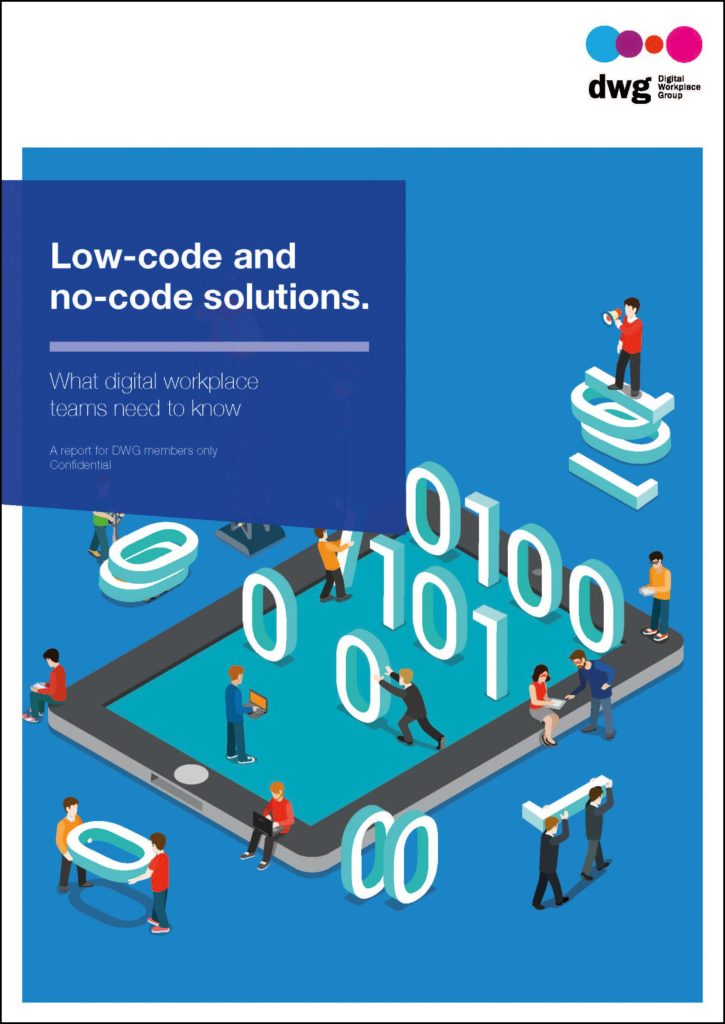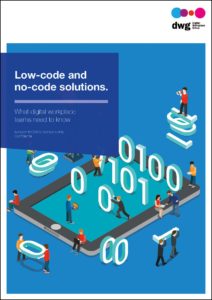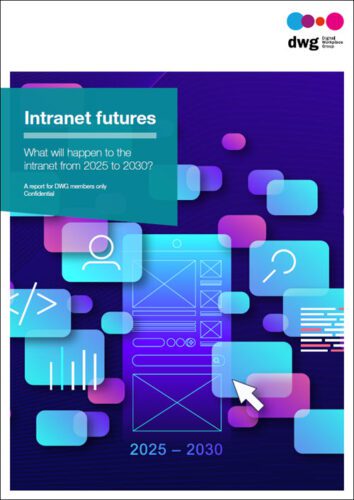Low-code and no-code solutions: 7 takeaways for digital workplace teams
‘Low-code’ and ‘no-code’ are currently two of the most widely used phrases to describe applications and technology solutions. While these are often used as marketing terms, they do reflect an important trend in software development, where there are more and more opportunities for IT teams, power-users and citizen developers to work together to create their own custom applications, dashboards and workflows. These capabilities are principally delivered by configuration and working through an interface and authoring canvas, rather than writing lines of code.

Low-code and no-code (LCNC) solutions are providing exciting opportunities for non-IT professionals to start to create their own simple solutions that can improve business processes right through the enterprise. LCNC software also enables IT developers to use configuration in conjunction with more traditional code to increase the speed and volume of their own output, while enabling power-users and citizen developers to be involved in development also frees up the time of central IT developers, allowing them to focus on more complex coding.
In a recent DWG research report, Low-code and no-code solutions: What digital workplace teams need to know, we explored the impact and influence that LCNC solutions, such as Microsoft’s Power Platform or ServiceNow, are having on the digital workplace, and looked at what digital workplace teams need to know and do in order to get the best out of them and support employees.
Although the full report is available to DWG members only, an excerpt of the report is available for all to download.
Here are seven takeaways from the report.
1. The distinction between low-code and no-code can get fuzzy
On the face of it, low-code and no-code solutions are distinct. A no-code solution is designed to be used by power-users – and even end-users – and requires no coding experience; a low-code solution is designed to be used by IT professionals and technically confident power-users and will involve some coding knowledge.
However, the report argues that the distinction between the two can get rather fuzzy. No-code solutions are also used by IT professionals, while a governance framework may require a review by an IT professional of any output delivered by a citizen developer using a no-code solution. No-code efforts can also sometimes be supplemented by coding, although not always. Therefore, a completely ‘no-code’ solution is something of a misnomer.
2. There are multiple benefits but there are also risks
LCNC solutions provide a range of exciting benefits for organizations. The report lists a number of these, including:
- driving overall digital transformation across an organization
- providing a platform for rapid application development
- creating local custom workflows and applications across the business that otherwise would be difficult to create at scale
- saving on IT resources – both time and costs
- increasing the digital confidence and capabilities of non-IT professionals
- supporting innovation.
At the same time there are also risks involved in deploying LCNC solutions, which might include:
- an inability to meet certain use cases, where a traditional software development approach might work better
- the risk of output created by citizen developers not meeting required standards, for example around security, privacy and usability
- not having the support resources in place to be able fully to exploit an LCNC platform, or where the support required negates any time or resources saved
- the output from LCNC solutions bypasses central governance standards across the digital workplace
- a LCNC solution is not truly scalable
- there is a lack of clarity around ownership and associated roles relating to a LCNC solution and who is responsible for it, which can lead to solutions not being sustainable
- some specialist skills may still be required to get the best out of a LCNC solution.
3. Governance of low-code and no-code solutions is essential
To mitigate for these risks and to support the main benefits of LCNC solutions, having some kind of governance framework in place is essential. The report defines governance as the ‘rules, roles, standards, controls, guidelines and policies’ that will help ensure LCNC solutions will be successful.
Defining governance helps to ensure that LCNC output meets appropriate standards, is sustainable, and safeguards the strategic relevance and direction of both LCNC platforms and their relative output. The report goes into some detail on what a governance framework should cover, including defining ownership and responsibilities, processes for the technical review of the work of citizen developers, standards covering everything from data privacy to ethics, and product and platform management approaches.
4. Continuous improvement and community-driven approaches help
The DWG report suggests a six-point framework for digital workplace teams to support LCNC solutions, ensuring there are the right standards and skills in place; these points include taking a community-driven approach as well as committing to continuous improvement.
LCNC solutions usually involve citizen developers who require ongoing support and engagement. Using champion networks, creating support communities and adopting community management approaches can all help to make a LCNC programme more sustainable and will provide forums for citizen developers and power-users to learn from and inspire each other.
Meanwhile, ensuring continuous improvement around LCNC solutions by using measurement and analytics, incorporating user feedback and driving iterative changes, can support an overall LCNC programme, where practices and approaches are often evolving and user input will help drive adoption.
5. Low-code provides opportunities for rapid application development
Low-code and no-code solutions are usually associated with use by non-IT professionals; however, they are frequently also used by IT teams to support a programme of rapid application development. By reducing the time spent on coding and reusing standard codes and ‘recipes’, teams can significantly reduce the time to market for new apps. This means IT development teams can better meet aggressive deadlines, be more agile and flexible in the face of customer demands, lessen the reliance on specialist developers, and reduce their overall costs.
6. Digital workplace teams are already leveraging low-code and no-code
LCNC solutions are already in use across most digital workplaces and, in practice, most digital workplace teams are already leveraging their potential. In fact, one of the three key use cases for LCNC solutions covered in the report is empowering channel and site owners across the digital workplace. Digital workplace teams can ensure stakeholders across the enterprise are as self-sufficient as possible in being able to create, configure and manage their own sites, minimizing the support they need from central IT, digital workplace and IT teams. This not only enables decentralized approaches to managing the digital workplace but also makes it more engaging for local site owners.
7. Citizen development is a journey
A lot of attention is currently being given to citizen development programmes, and more and more organizations are starting to formalize their approaches to this. Here, it is important not always to expect instant success; it can be a learning curve both for citizen developers, as well as for the digital workplace teams supporting the programme. The report suggests that: “improving as you go based on experiences and lessons learned is a positive mindset to adopt”.
Download the free report excerpt
Low-code and no-code solutions:
What digital workplace teams need to know
Talk to us about…

… becoming a DWG member
Categorised in: Research reports


